Table of Contents
Guide
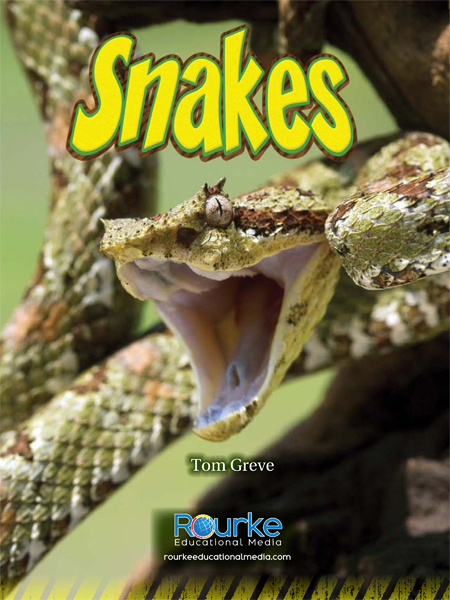

2012 Rourke Educational Media All rights reserved. No part of this book may be reproduced or utilized in any form or by any means, electronic or mechanical including photocopying, recording, or by any information storage and retrieval system without permission in writing from the publisher. www.rourkeeducationalmedia.com PHOTO CREDITS: : Rikke68; Edited by Precious McKenzie Cover Design by Renee Brady
Interior Design by Tara Raymo Library of Congress Cataloging-in-Publication Data Greve, Tom
Snakes / Tom Greve.
p. cm. -- (Eye to Eye with Animals)
ISBN 978-1-61741-776-4 (hard cover) (alk. paper)
ISBN 978-1-61741-978-2 (soft cover)
Library of Congress Control Number: 2011924821 Rourke Educational Media
Printed in the United States of America,
North Mankato, Minnesota
 rourkeeducationalmedia.com
rourkeeducationalmedia.com PO Box 643328 Vero Beach, Florida 32964
Chapter 1
Monstrously Misunderstood
They are slithering, and legless.
Snakes are often portrayed as cold-blooded killers that give many people a serious case of the creeps. In reality, snakes pose little threat to humans.  Corn Snake
Corn Snake Like all animals, snakes bodies grow as they get older, but their outer skin does not grow. As a result, snakes regularly shed their skin. While their and fascinating creatures.
Like all animals, snakes bodies grow as they get older, but their outer skin does not grow. As a result, snakes regularly shed their skin. While their and fascinating creatures.
Chapter 2
Living Life Without Limbs
Snakes are a part of the reptile family of animals. All reptile have scaly skin, a backbone, and are cold-blooded.
But unlike most reptiles, snakes do not have arms or legs. 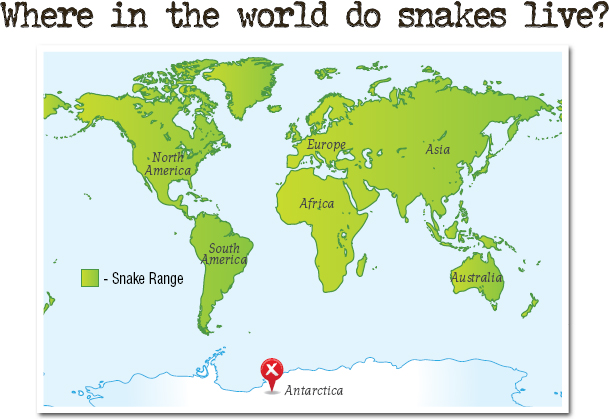 There are about 3,000 different species of snakes on Earth. They live on every continent except Antarctica. Snakes generally live in warmer . They can live in or near oceans, rivers, swamps, jungles, and even deserts.
There are about 3,000 different species of snakes on Earth. They live on every continent except Antarctica. Snakes generally live in warmer . They can live in or near oceans, rivers, swamps, jungles, and even deserts. 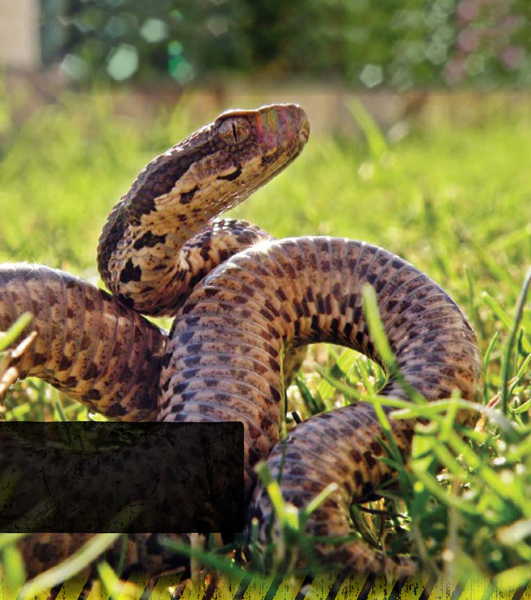 Garter SnakeSnakes lie in the sun or coil their bodies to stay warm. They can use shade or water to stay cool.
Garter SnakeSnakes lie in the sun or coil their bodies to stay warm. They can use shade or water to stay cool.
If it gets too cold, many snakes virtually shut down their body functions until warmer temperatures return. KNOWING HOW TO CHILL OUT Cold-blooded animals like snakes are said to be ectothermic. This means that they cannot maintain their body temperature internally, they rely on their environment to keep their bodies warm or cool. Snakes are among natures best example of a species that has learned to pace itself. Like most reptiles, they use only as much energy as needed to stay warm, catch at bay. 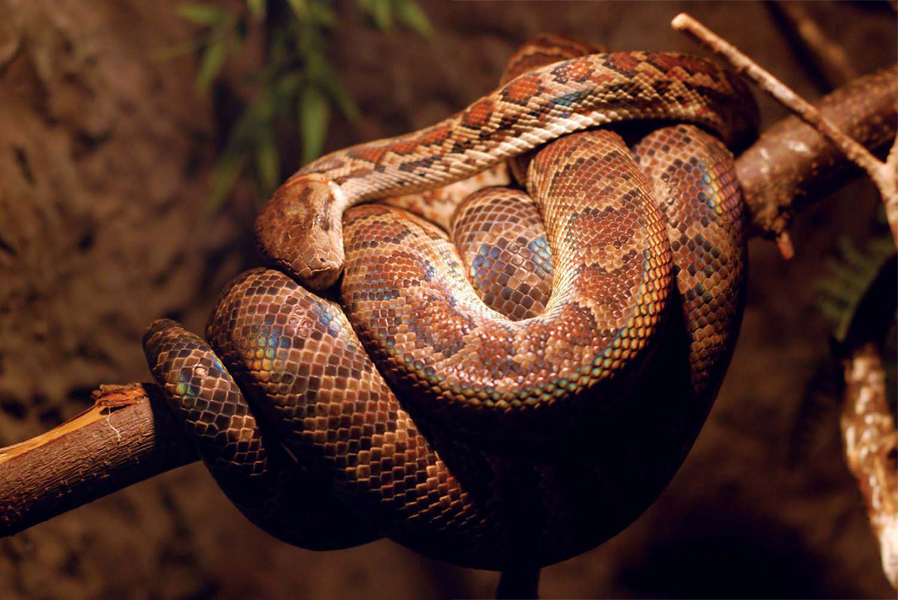 Boa ConstrictorPart of snakes amazing ability to conserve energy is their efficient digestive system. Once theyve eaten, snakes can wait long periods of time before they get hungry again.
Boa ConstrictorPart of snakes amazing ability to conserve energy is their efficient digestive system. Once theyve eaten, snakes can wait long periods of time before they get hungry again.
This is especially true of larger snakes which typically eat large prey. Snakes have . 
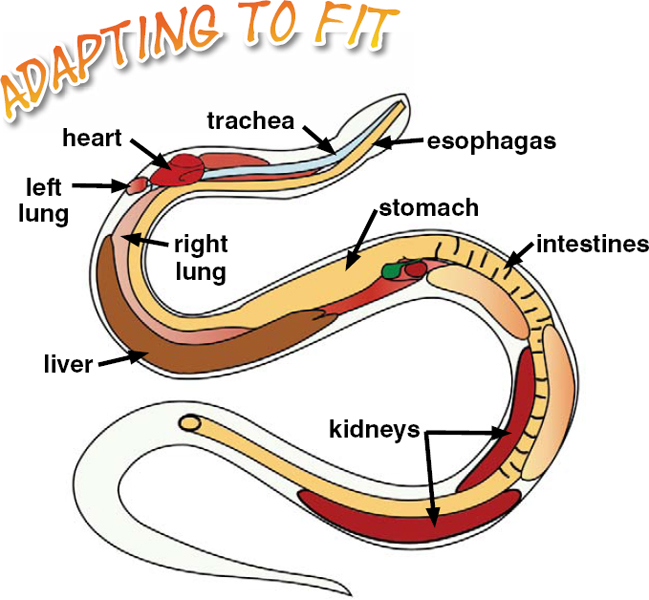 The internal organs of snakes are elongated and staggered rather than side-by-side so they can fit inside their long tube-shaped bodies. Instead of relying on eyes and ears to see and hear, snakes rely on their forked tongues to sense danger or to find food.
The internal organs of snakes are elongated and staggered rather than side-by-side so they can fit inside their long tube-shaped bodies. Instead of relying on eyes and ears to see and hear, snakes rely on their forked tongues to sense danger or to find food.  Garter SnakeA snakes tongue is attached to its Jacobsons Organ a sensory organ in the roof of its mouth which processes scents in the air caught by the tongue. Snakes do not have external ears and never close their eyes. Instead of moveable eyelids, they have special clear lenses to keep their eyes moist and protected.
Garter SnakeA snakes tongue is attached to its Jacobsons Organ a sensory organ in the roof of its mouth which processes scents in the air caught by the tongue. Snakes do not have external ears and never close their eyes. Instead of moveable eyelids, they have special clear lenses to keep their eyes moist and protected.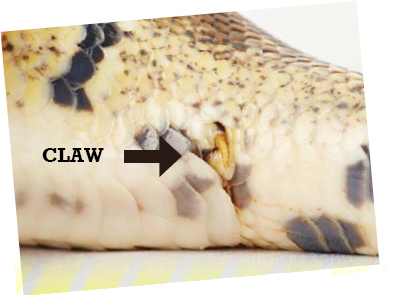 Some snake species still have tiny, useless limbs that resemble a tiny claw. Scientists believe these are the leftovers of hind legs which they lost as they evolved from lizards. Most snakes by laying eggs, especially those that live in warmer climates.
Some snake species still have tiny, useless limbs that resemble a tiny claw. Scientists believe these are the leftovers of hind legs which they lost as they evolved from lizards. Most snakes by laying eggs, especially those that live in warmer climates.
But some snakes give birth to live young. 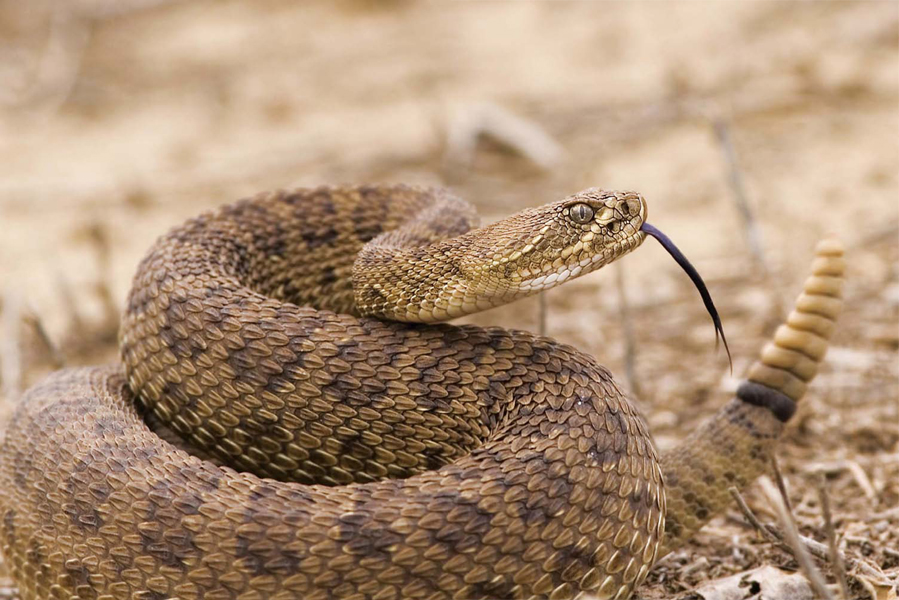
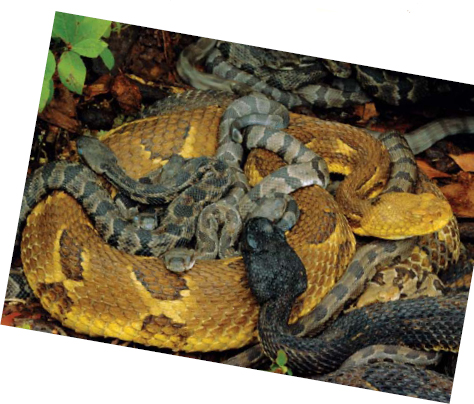 Among the best-known and most feared North American snakes are rattlesnakes. Female rattlers give birth to between five and twenty live baby rattlers at a time. Theyre born ready to defend themselves from predators. RADICAL RATTLERS There are about thirty different species of rattlesnakes. They are known as pit vipers, because they use special pit sensors along their jaws to help them detect heat from warm-blooded prey.
Among the best-known and most feared North American snakes are rattlesnakes. Female rattlers give birth to between five and twenty live baby rattlers at a time. Theyre born ready to defend themselves from predators. RADICAL RATTLERS There are about thirty different species of rattlesnakes. They are known as pit vipers, because they use special pit sensors along their jaws to help them detect heat from warm-blooded prey.
Chapter 3
Freaky Feasts
Despite having no arms or legs, snakes are incredibly shrewd and efficient hunters.
All snakes are carnivores. Some snakes kill by biting and injecting toxic into their prey. Other snakes are constrictors. They attack by wrapping their long bodies around their prey and squeezing, or constricting, it to death. 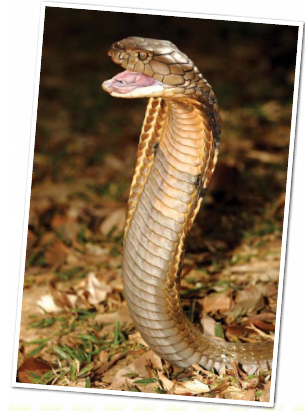 The king cobra is the worlds longest venomous snake. Like rattlesnakes, king cobras inject venom into prey through their fangs.
The king cobra is the worlds longest venomous snake. Like rattlesnakes, king cobras inject venom into prey through their fangs.
One toxic bite can kill much larger animals, but king cobrasusually bite only as a defense when bothered. Dont worry, they only eat other snakes. Some snakes are passive hunters. They use their skin coloration to blend in with their surroundings as they wait for prey to come to them. Other snakes are active hunters. They move around looking for prey.  DESERT HORNED VIPER A great example of passive hunting skill, the desert horned viper can hide its body under the sand of its desert habitat.
DESERT HORNED VIPER A great example of passive hunting skill, the desert horned viper can hide its body under the sand of its desert habitat.
Only its eyes remain above the sand, leaving it hidden from view of the small lizards it likes to eat. In one of natures most feeding routines, snakes swallow their prey whole. Many times, the prey is actually larger than the snakes head! HOW DO THEY DO THAT? 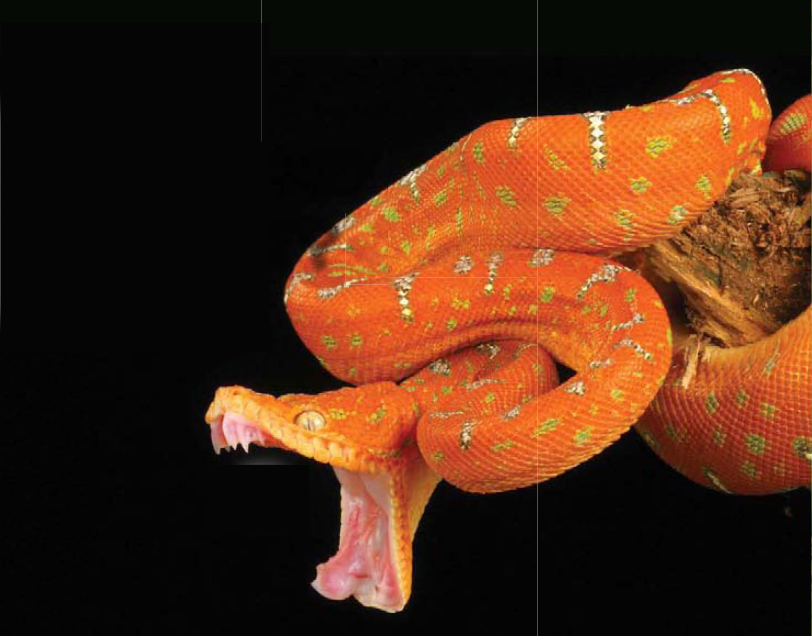

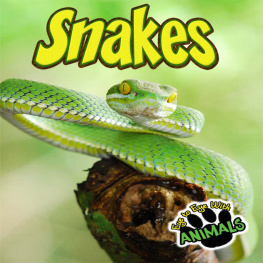
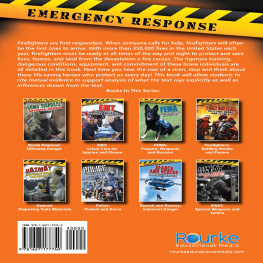



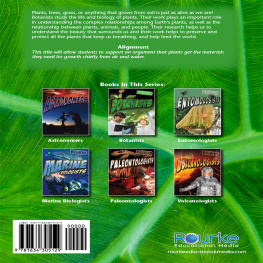

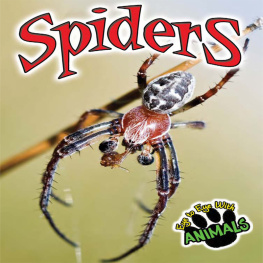
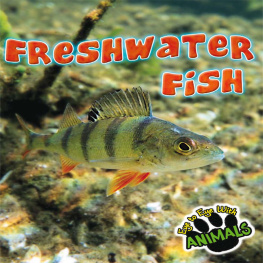


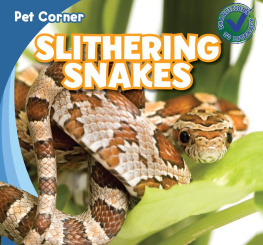

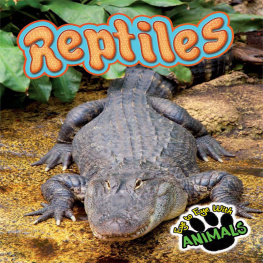



 2012 Rourke Educational Media All rights reserved. No part of this book may be reproduced or utilized in any form or by any means, electronic or mechanical including photocopying, recording, or by any information storage and retrieval system without permission in writing from the publisher. www.rourkeeducationalmedia.com PHOTO CREDITS: : Rikke68; Edited by Precious McKenzie Cover Design by Renee Brady
2012 Rourke Educational Media All rights reserved. No part of this book may be reproduced or utilized in any form or by any means, electronic or mechanical including photocopying, recording, or by any information storage and retrieval system without permission in writing from the publisher. www.rourkeeducationalmedia.com PHOTO CREDITS: : Rikke68; Edited by Precious McKenzie Cover Design by Renee Brady rourkeeducationalmedia.com PO Box 643328 Vero Beach, Florida 32964
rourkeeducationalmedia.com PO Box 643328 Vero Beach, Florida 32964  Corn Snake
Corn Snake Like all animals, snakes bodies grow as they get older, but their outer skin does not grow. As a result, snakes regularly shed their skin. While their and fascinating creatures.
Like all animals, snakes bodies grow as they get older, but their outer skin does not grow. As a result, snakes regularly shed their skin. While their and fascinating creatures. There are about 3,000 different species of snakes on Earth. They live on every continent except Antarctica. Snakes generally live in warmer . They can live in or near oceans, rivers, swamps, jungles, and even deserts.
There are about 3,000 different species of snakes on Earth. They live on every continent except Antarctica. Snakes generally live in warmer . They can live in or near oceans, rivers, swamps, jungles, and even deserts.  Garter SnakeSnakes lie in the sun or coil their bodies to stay warm. They can use shade or water to stay cool.
Garter SnakeSnakes lie in the sun or coil their bodies to stay warm. They can use shade or water to stay cool. Boa ConstrictorPart of snakes amazing ability to conserve energy is their efficient digestive system. Once theyve eaten, snakes can wait long periods of time before they get hungry again.
Boa ConstrictorPart of snakes amazing ability to conserve energy is their efficient digestive system. Once theyve eaten, snakes can wait long periods of time before they get hungry again.
 The internal organs of snakes are elongated and staggered rather than side-by-side so they can fit inside their long tube-shaped bodies. Instead of relying on eyes and ears to see and hear, snakes rely on their forked tongues to sense danger or to find food.
The internal organs of snakes are elongated and staggered rather than side-by-side so they can fit inside their long tube-shaped bodies. Instead of relying on eyes and ears to see and hear, snakes rely on their forked tongues to sense danger or to find food.  Garter SnakeA snakes tongue is attached to its Jacobsons Organ a sensory organ in the roof of its mouth which processes scents in the air caught by the tongue. Snakes do not have external ears and never close their eyes. Instead of moveable eyelids, they have special clear lenses to keep their eyes moist and protected.
Garter SnakeA snakes tongue is attached to its Jacobsons Organ a sensory organ in the roof of its mouth which processes scents in the air caught by the tongue. Snakes do not have external ears and never close their eyes. Instead of moveable eyelids, they have special clear lenses to keep their eyes moist and protected. Some snake species still have tiny, useless limbs that resemble a tiny claw. Scientists believe these are the leftovers of hind legs which they lost as they evolved from lizards. Most snakes by laying eggs, especially those that live in warmer climates.
Some snake species still have tiny, useless limbs that resemble a tiny claw. Scientists believe these are the leftovers of hind legs which they lost as they evolved from lizards. Most snakes by laying eggs, especially those that live in warmer climates.
 Among the best-known and most feared North American snakes are rattlesnakes. Female rattlers give birth to between five and twenty live baby rattlers at a time. Theyre born ready to defend themselves from predators. RADICAL RATTLERS There are about thirty different species of rattlesnakes. They are known as pit vipers, because they use special pit sensors along their jaws to help them detect heat from warm-blooded prey.
Among the best-known and most feared North American snakes are rattlesnakes. Female rattlers give birth to between five and twenty live baby rattlers at a time. Theyre born ready to defend themselves from predators. RADICAL RATTLERS There are about thirty different species of rattlesnakes. They are known as pit vipers, because they use special pit sensors along their jaws to help them detect heat from warm-blooded prey. The king cobra is the worlds longest venomous snake. Like rattlesnakes, king cobras inject venom into prey through their fangs.
The king cobra is the worlds longest venomous snake. Like rattlesnakes, king cobras inject venom into prey through their fangs. DESERT HORNED VIPER A great example of passive hunting skill, the desert horned viper can hide its body under the sand of its desert habitat.
DESERT HORNED VIPER A great example of passive hunting skill, the desert horned viper can hide its body under the sand of its desert habitat.